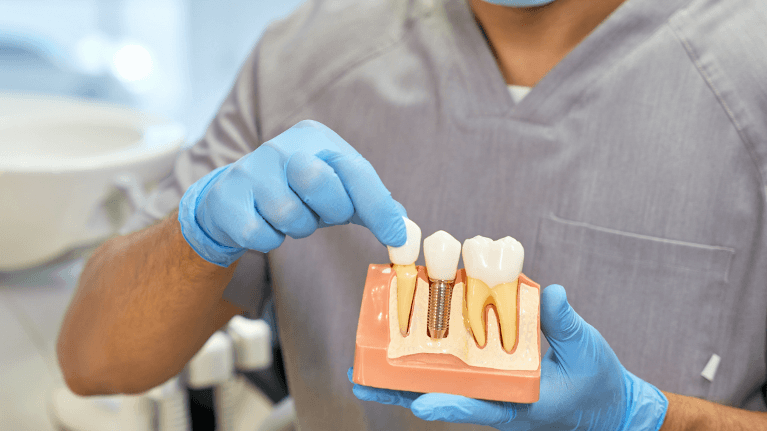
When it comes to replacing missing teeth, modern cosmetic dentistry offers numerous treatments to suit budget and lifestyle needs. Two of our most common tooth replacement options are dental implants and bridges.
Choosing between these treatments isn’t just about cost; we also consider long-term health, durability, and personal needs. Understanding the benefits and drawbacks of each procedure can help you make an informed decision about your smile.
Overview of Bridges and Dental Implants
While both options offer high-quality and dependable tooth replacement solutions, they differ in terms of lifespan, cost, and procedure. Bridges use adjacent teeth for support when replacing a missing tooth. The procedure is minimally invasive and offers quick, affordable, and natural-looking results. Bridges have a lifespan of between five and fifteen years and typically require two to three appointments to complete.
Implants provide a more permanent solution to missing teeth. The application involves surgically inserting a small post into the jawbone, which gradually fuses with the surrounding bone. The merging contributes to positive jawbone health and stability, providing long-term dental solutions to missing teeth. Implants deliver a natural and durable finish, and do not depend on surrounding teeth to maintain their structure.
Are There Different Types of Dental Bridges Available?
The constant evolution of dental practices results in numerous options for missing tooth restorations tailored to individual needs. We offer four types of dental bridges to suit your gum health, budget, and oral requirements.
Traditional Bridges
A typical bridge consists of one or more ‘false’ teeth, held in place by healthy teeth on either side. These supporting teeth are fitted with crowns to ensure a secure fit. We use these for patients with strong surrounding teeth.
Cantilever Bridges
Similar to traditional bridges, this treatment supports the pontic – the artificial tooth in a dental bridge – with a crown on only one of the adjacent teeth. The natural tooth is modified to hold the bridge firmly in place. These work best in cases where there is only one natural tooth available for support.
Resin-Bonded Bridges
We use this restoration method for single-tooth gaps using a framework fitted onto flanking teeth. The winged extensions bond onto your natural teeth using a resin cement mixture. This alternative bridge model requires little preparation, preserving your natural abutment teeth. They work best for replacing missing front teeth with minimal bite and chew force.
Implant-Supported Bridges
This modern solution utilizes surgically placed implants as anchors to support the bridge. Acting as artificial tooth roots, the implants provide a strong foundation without the requirements of natural teeth. This treatment is ideal for patients who are missing multiple teeth or require a more stable approach.
Expected Lifespan of Dental Implants vs Bridges
Dental implants have a significantly longer lifespan than bridges due to their procedure and materials used. The titanium tooth root is designed to last a lifetime, with its adjoining crown lasting up to 15 years. This durable dental restoration option does not put stress on neighboring teeth, further preserving the health of your natural teeth as well.
A bridge can last between 7 and 15 years, depending on its placement. Since bridges rely on adjacent teeth for support, they may need replacement sooner if the supporting teeth become damaged.
What Are the Aesthetic Pros and Cons of Implants vs Bridges
Dental implants offer superior form and function, mimicking the look of natural teeth while preserving bone structure. While they involve a more in-depth surgical process, the results often look and feel more natural than bridges. Dental bridges offer a quicker and more affordable treatment option, while still yielding aesthetically pleasing results. The process involves reshaping adjacent supporting teeth, which can look less natural over time.
Pros of Dental Implants
- They provide a natural appearance, blending the color, shape, and size of your existing teeth for a uniform smile.
- Stimulates the jawbone, which can help in preventing bone loss and maintaining your facial structure.
Cons of Dental Implants
- The process of placing implants requires multiple appointments before surgery, as well as a lengthy recovery time. A temporary plate may be necessary while the implant fuses to the jawbone.
- While implants usually cost more initially than bridges, they can reduce future dental work, making them more cost-effective in the long run.
Pros of Dental Bridges
- The application process is relatively quick, involving roughly two visits over a few weeks from taking impressions to final placement.
- Bridges can achieve a natural-looking and realistic result to match the appearance of your existing teeth.
Cons of Dental Bridges
- The process requires altering and prepping healthy nearby teeth for support, which is an irreversible procedure.
- Bridges do not stimulate the jawbone, which can lead to future bone loss in the area where the tooth is missing.
Who Is a Good Candidate for Implants or Bridges?
Dental implants and bridges can restore your smile. Still, the choice of treatment depends on your oral health, bone density, and personal preferences.
Implants are ideal for patients with healthy gums and jawbone, or those seeking long-term dental solutions. Bridges may be suitable for patients who prefer a quicker, less invasive option or have adjacent teeth that can support the restoration.
To determine the best option for your unique needs, schedule a consultation with us. We’re a trusted cosmetic dentist practice, specializing in implants, bridges, and more.